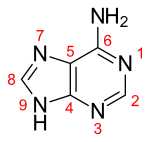Adenine
 | |||
| |||
| Names | |||
|---|---|---|---|
| IUPAC name
9H-purin-6-amine | |||
| Other names
6-aminopurine | |||
| Identifiers | |||
| 73-24-5 | |||
| 3D model (Jmol) | Interactive image Interactive image | ||
| ChEBI | CHEBI:16708 | ||
| ChEMBL | ChEMBL226345 | ||
| ChemSpider | 185 | ||
| DrugBank | DB00173 | ||
| ECHA InfoCard | 100.000.724 | ||
| EC Number | 200-796-1 | ||
| 4788 | |||
| KEGG | D00034 | ||
| PubChem | 190 | ||
| RTECS number | AU6125000 | ||
| UNII | JAC85A2161 | ||
| |||
| |||
| Properties | |||
| C5H5N5 | |||
| Molar mass | 135.13 g/mol | ||
| Appearance | white to light yellow, crystalline | ||
| Density | 1.6 g/cm3 (calculated) | ||
| Melting point | 360 to 365 °C (680 to 689 °F; 633 to 638 K) decomposes | ||
| 0.103 g/100 mL | |||
| Solubility | negligible in ethanol | ||
| Acidity (pKa) | 4.15 (secondary), 9.80 (primary)[1] | ||
| Thermochemistry | |||
| 147.0 J/(K·mol) | |||
| Std enthalpy of formation (ΔfH |
96.9 kJ/mol | ||
| Hazards | |||
| Safety data sheet | MSDS | ||
| Lethal dose or concentration (LD, LC): | |||
| LD50 (median dose) |
227 mg/kg (rat, oral) | ||
| Except where otherwise noted, data are given for materials in their standard state (at 25 °C [77 °F], 100 kPa). | |||
| | |||
| Infobox references | |||
Adenine /ˈædᵻnᵻn/ (A, Ade) is a nucleobase (a purine derivative). Its derivatives have a variety of roles in biochemistry including cellular respiration, in the form of both the energy-rich adenosine triphosphate (ATP) and the cofactors nicotinamide adenine dinucleotide (NAD) and flavin adenine dinucleotide (FAD). It also has functions in protein synthesis and as a chemical component of DNA and RNA.[2] The shape of adenine is complementary to either thymine in DNA or uracil in RNA.
The image on the right shows pure adenine, as an independent molecule. When connected into DNA, a covalent bond is formed between deoxyribose sugar and the bottom left nitrogen, so removing the hydrogen. The remaining structure is called an adenine residue, as part of a larger molecule. Adenosine is adenine reacted with ribose as used in RNA and ATP; deoxyadenosine adenine attached to deoxyribose, as is used to form DNA.
Structure

Adenine forms several tautomers, compounds that can be rapidly interconverted and are often considered equivalent. However, in isolated conditions, i.e. in an inert gas matrix and in the gas phase, mainly the 9H-adenine tautomer is found.[3][4]
Biosynthesis
Purine metabolism involves the formation of adenine and guanine. Both adenine and guanine are derived from the nucleotide inosine monophosphate (IMP), which in turn is synthesized from a pre-existing ribose phosphate through a complex pathway using atoms from the amino acids glycine, glutamine, and aspartic acid, as well as the coenzyme tetrahydrofolate.
Function
Adenine is one of the two purine nucleobases (the other being guanine) used in forming nucleotides of the nucleic acids. In DNA, adenine binds to thymine via two hydrogen bonds to assist in stabilizing the nucleic acid structures. In RNA, which is used for protein synthesis, adenine binds to uracil.
 |
 |
 |
 |
| A-T-Base-pair (DNA) | A-U-Base-pair (RNA) | A-D-Base-pair (RNA) | A-Ψ-Base-pair (RNA) |
Adenine forms adenosine, a nucleoside, when attached to ribose, and deoxyadenosine when attached to deoxyribose. It forms adenosine triphosphate (ATP), a nucleoside triphosphate, when three phosphate groups are added to adenosine. Adenosine triphosphate is used in cellular metabolism as one of the basic methods of transferring chemical energy between chemical reactions.


Adenosine, A Deoxyadenosine, dA
History
.jpg)
In older literature, adenine was sometimes called Vitamin B4.[5] It is no longer considered a true vitamin or part of the Vitamin B complex. However, two B vitamins, niacin and riboflavin, bind with adenine to form the essential cofactors nicotinamide adenine dinucleotide (NAD) and flavin adenine dinucleotide (FAD), respectively. Hermann Emil Fischer was one of the early scientists to study adenine.
It was named in 1885 by Albrecht Kossel, in reference to the pancreas (a specific gland - in Greek, "aden") from which Kossel's sample had been extracted.[6][7]
Experiments performed in 1961 by Joan Oró have shown that a large quantity of adenine can be synthesized from the polymerization of ammonia with five hydrogen cyanide (HCN) molecules in aqueous solution;[8] whether this has implications for the origin of life on Earth is under debate.[9]
On August 8, 2011, a report, based on NASA studies with meteorites found on Earth, was published suggesting building blocks of DNA and RNA (adenine, guanine and related organic molecules) may have been formed extraterrestrially in outer space.[10][11][12] In 2011, physicists reported that adenine has an "unexpectedly variable range of ionization energies along its reaction pathways" which suggested that "understanding experimental data on how adenine survives exposure to UV light is much more complicated than previously thought"; these findings have implications for spectroscopic measurements of heterocyclic compounds, according to one report.[13]
References
- ↑ Dawson, R.M.C., et al., Data for Biochemical Research, Oxford, Clarendon Press, 1959.
- ↑ Definition of Adenine from the Genetics Home Reference - National Institutes of Health
- ↑ Plützer, Chr.; Kleinermanns, K. (2002). "Tautomers and electronic states of jet-cooled adenine investigated by double resonance spectroscopy". Phys.Chem.Chem.Phys. 4 (20): 4877–4882. Bibcode:2002PCCP....4.4877P. doi:10.1039/b204595h.
- ↑ M. J. Nowak; H. Rostkowska; L. Lapinski; J. S. Kwiatkowski; J. Leszczynski (1994). "Experimental matrix isolation and theoretical ab initio HF/6-31G(d, p) studies of infrared spectra of purine, adenine and 2-chloroadenine,". Spectrochimica Acta Part A: Molecular Spectroscopy. 50 (6): 1081–1094. Bibcode:1994AcSpA..50.1081N. doi:10.1016/0584-8539(94)80030-8. ISSN 0584-8539.
- ↑ Reader V (1930). "The assay of vitamin B(4)". The Biochemical Journal. 24 (6): 1827–31. doi:10.1042/bj0241827. PMC 1254803
 . PMID 16744538.
. PMID 16744538. - ↑ A. Kossel (1885) "Ueber eine neue Base aus dem Thierkörper" (On a new base from the animal body), Berichte der Deutschen Chemischen Gesellschaft zu Berlin, 18 : 79-81. From p. 79: "Diese Base, für welche ich den Namen Adenin vorschlage, wurde zunächst aus Pankreasdrüsen vom Rind dargestellt." (This base, for which I suggest the name "adenine", was first prepared from the pancreas glands of steer.)
- ↑ Online Etymology Dictionary by Douglas Harper
- ↑ Oro J, Kimball AP (August 1961). "Synthesis of purines under possible primitive earth conditions. I. Adenine from hydrogen cyanide". Archives of Biochemistry and Biophysics. 94 (2): 217–27. doi:10.1016/0003-9861(61)90033-9. PMID 13731263.
- ↑ Shapiro, Robert (June 1995). "The prebiotic role of adenine: A critical analysis". Origins of Life and Evolution of Biospheres. 25 (1–3): 83–98. Bibcode:1995OLEB...25...83S. doi:10.1007/BF01581575.
- ↑ Callahan MP, Smith KE, Cleaves HJ, Ruzicka J, Stern JC, Glavin DP, House CH, Dworkin JP (Aug 2011). "Carbonaceous meteorites contain a wide range of extraterrestrial nucleobases". Proceedings of the National Academy of Sciences of the United States of America. 108 (34): 13995–8. doi:10.1073/pnas.1106493108. PMC 3161613
 . PMID 21836052.
. PMID 21836052. - ↑ Steigerwald, John (8 August 2011). "NASA Researchers: DNA Building Blocks Can Be Made in Space". NASA. Retrieved 2011-08-10.
- ↑ ScienceDaily Staff (9 August 2011). "DNA Building Blocks Can Be Made in Space, NASA Evidence Suggests". ScienceDaily. Retrieved 2011-08-09.
- ↑ Williams P (August 18, 2011). "Physicists Uncover New Data On Adenine, a Crucial Building Block of Life". Science Daily. Retrieved 2011-09-01.
journal reference: Mario Barbatti, Susanne Ullrich. Ionization potentials of adenine along the internal conversion pathways. Physical Chemistry Chemical Physics, 2011; doi:10.1039/C1CP21350D -- a University of Georgia physicist and a collaborator in Germany have shown that ... adenine, has an unexpectedly variable range of ionization energies along its reaction pathways....
External links
| Wikimedia Commons has media related to Adenine. |

